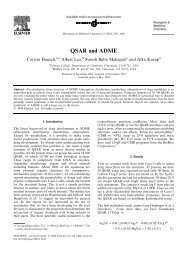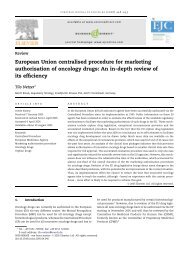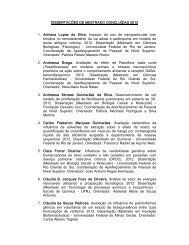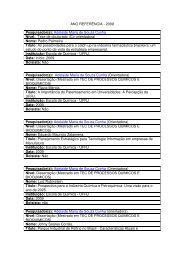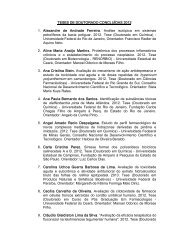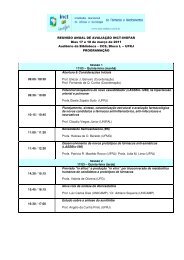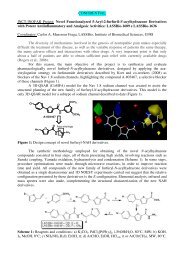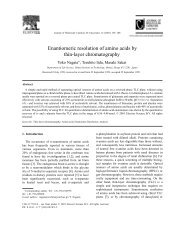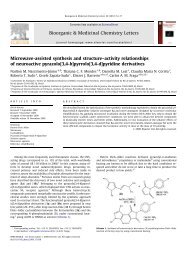4340 Journal of Medicinal Chemistry, 2004, Vol. 47, No. 18 PerspectiveThis is in clear distinction from classical prodrugs,which involve a biologically inactive compound beingconverted to a biologically active one by chemical orenzymatic means (usually via hydrolytic biotransformation).The concept of active metabolite as defined hereis also distinct from reactive metabolites, which arechemically reactive intermediates formed during metabolismthat may elicit toxicological activity throughcovalent binding to biomolecules. The importance of anactive metabolite is measured by the degree of itscontribution to the total pharmacological activity of agiven dose of the parent compound and by its intrinsicactivity and the relative concentration at the site ofaction. 13,14Generation of Chemical Diversity throughBiological TransformationFigure 1. Examples of common biotransformation reactionsthat led to pharmacologically active or inactive metabolites.sulfation of acetaminophen leads to bioinactivation(Figure 1). The 6-O-glucuronide metabolite of morphineis pharmacologically active, whereas morphine 3-Oglucuronideis not (Figure 1). 12 In silico methods havethe potential to predict and assess the formation ofmetabolites from a precursor compound and whetherthese metabolites are active against known pharmacologicaltargets. However, a robust in silico method thatcould fulfill these objectives across a wide variety ofchemical space has yet to be developed. Therefore,experimental methods are needed to generate, detect,and characterize important active metabolites. In thispaper, we will discuss the importance of embracing theconcept of active metabolites as part of the drug designprocess and will review experimental observations thatcan trigger the search for active metabolites. We willalso discuss methodological advances in the detection,generation, and structural characterization of activemetabolites.Definition of an Active MetaboliteHere, we define an active metabolite as a pharmacologicallyactive metabolic product with activity againstthe same pharmacological target as the parent molecule.Current drug discovery paradigms involve (1) randomor directed screening of natural or synthetic productlibraries, (2) combinatorial chemistry and molecularmodification of pharmacologically active synthetic ornatural products, and (3) a de novo rational drug design.As described above, discovering drugs by methods ofbiological transformation may also be a viable approachto drug design. It is therefore beneficial to have methodsin place to allow screening of compounds for therapeuticallyuseful biotransformation products or active metabolitesduring the drug discovery phase.During lead optimization, drug candidates are routinelyscreened for metabolic stability or in vivo systemicexposure and rank-ordered according to the rate andextent of metabolism or systemic exposure level. 15 Inthe case of metabolic screening, this is usually performedin vitro after incubations of the drug candidateswith subcellular fractions such as liver microsomes orintact cellular systems (e.g., hepatocytes) containing afull complement of drug-metabolizing enzymes. Compoundswith low metabolic stability are then excludedfrom further consideration because most therapeutictargets require compounds with an extended pharmacokinetichalf-life. The same is true with in vivoexposure studies, where high-clearance compounds arediscarded. In these early screens, the concentration ofthe parent compound is typically the only measurementmade. Consequently, there is no information on thenumber, identity, and pharmacological significance ofmetabolites that may have been formed. Even whenmetabolic profiling is completed and metabolites areidentified, the information is typically used to directsynthesis of analogues with improved metabolic stabilitythrough the modification of metabolic soft or hot spots. 16,17Thus, the information is rarely used for the purpose ofsearching for pharmacologically active products as newanalogues. However, rapid metabolism of parent compoundscan lead to the formation of pharmacologicallyactive metabolites that may have comparatively superior“developability” characteristics. As a result, metabolicinstability, which otherwise may be considered aliability, can be used as an advantage during leadoptimization.
Perspective Journal of Medicinal Chemistry, 2004, Vol. 47, No. 18 4341Advantages of Tracking BiologicalTransformation during the Drug DesignProcessThere are a number of advantages for screening drugcandidates for active metabolites during drug discovery.The primary reason is that the process may lead to thediscovery of a drug candidate with superior drug developabilityattributes such as (1) improved pharmacodynamics,(2) improved pharmacokinetics, (3) lower probabilityfor drug-drug interactions, (4) less variablepharmacokinetics and/or pharmacodynamics, (5) improvedoverall safety profile, and (6) improved physicochemicalproperties (e.g., solubility).Other advantages of early screening for active metabolitesinclude the potential for modifications of theentire chemical class (chemotype) to improve overallcharacteristics. 1,18 Further, early discovery of activemetabolites provides a more complete patent protectionof the parent molecule. Additionally, tracking activemetabolites at the drug discovery stage will allow forthe correct interpretation of the pharmacological effectobserved in preclinical species in relation to a predictedeffect in humans. In other words, if an active metaboliteis responsible for significant activity in a species usedfor preclinical efficacy determination, there is a significantrisk that the effect will be dramatically differentin humans unless similar levels of metabolite areachieved in humans.Active metabolites possessing one or more of theabove attributes have been found for a number ofmarketed drugs and have led to the introduction of themetabolites as commercial products. Several examplesof active metabolites that have become marketed drugsare discussed below.Desloratadine (Clarinex) now marketed as a secondgenerationantihistamine agent is an active metaboliteof loratadine (Claritin) (Figure 2). It is approximately10-fold more potent in vivo in human than the parentdrug. 19,20 Desloratidine has lower oral clearance withgreater systemic concentrations at equivalent oral dosesand has a longer plasma elimination half-life comparedto the parent compound in human. As a result of itssuperior pharmacokinetics and pharmacodynamic profiles,the standard human dose is half as much as thatof loratadine. It also shows less pharmacokinetic variabilityin comparison to the parent drug. 21,22Morphine-6-O-glucuronide, a widely used analgesic,is an active metabolite of morphine possessing pharmacologicalactivity greater than that of the parentcompound (Figure 1). 23,24 Upon chronic treatment, thepharmacokinetic profile of morphine-6-O-glucuronideled to higher plasma concentrations than morphine,contributing to its better clinical effect. 25 Morphine-6-O-glucuronide also showed an improved side effectprofile, with a lower incidence of nausea and vomitingcommonly observed with the parent drug. 23Cetirizine (Zyrtec), a second-generation antihistamine,is an active metabolite of hydroxyzine (Atarax)(Figure 2). Cetirizine has greater affinity for the H 1receptor and, in contrast to hydroxyzine, is a nonsedatingagent at least partially because of its lack ofdistribution to brain tissue. 7,26Fexofenadine (Allegra), another antihistamine agent,is an active metabolite of terfenadine (Figure 2). 8,27Figure 2. Examples of biotransformation reactions that ledto active metabolites that have been developed and marketedas drugs.Terfenadine undergoes extensive first-pass metabolismthat is predominantly mediated by CYP3A4 and formsfexofenadine as the major circulating metabolite. Terfenadinewas shown to promote the inhibition of cardiacion channels (potassium ion currents) leading to prolongationof the QT c interval and ventricular arrhythmia.28,29 Coadministration of terfenadine with CYP3A4inhibitors such as ketoconazole significantly altered itspharmacokinetic profile, resulting in an increase inplasma concentration potentially leading to fatal cardiacarrhythmia. 30 In contrast, no change in the QT c intervalwas observed with fexofenadine when administeredalone or in combination with ketoconazole. As a result,terfenadine was withdrawn from the market and wasreplaced with fexofenadine.In most cases, further metabolism of active metabolitesleads to the formation of fewer total metabolitescompared to the parent compound. As a result, the useof an active metabolite as drug may lessen the chancefor off-target toxicity that may be caused by one or moreextra metabolites formed from the parent compound,even when the parent compound itself has no intrinsictoxicity. Moreover, most active metabolites are productsof phase I functionalization reactions and as such aremore susceptible to phase II conjugation reactions.Phase II conjugation reactions result in the formationof secondary metabolites that, in general, are safelycleared from the body. For example phenacetin, whichis no longer in use in humans, is metabolized to anumber of metabolites. Of the many phenacetin metabolicpathways, the O-deethylation pathway leads to theformation of acetaminophen (Figure 2) (a more analgesicagent than phenacetin), whereas N-hydroxylation ofphenacetin leads to the formation of a toxic metabolitethat induces methemoglobinemia and hemolytic ane-



